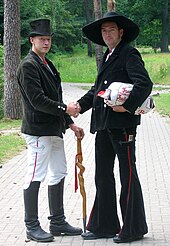Stenz
The term Stenz, which comes from Rotwelschen , describes both a stick or walking stick and - derived from it - a pimp or a womanizer. As root lift or an older stenzen meaning "come" is assumed.
Term for stick

The name has been used since 1687 at the latest - initially as Stemß , since the early 19th century as Stenz - in the meaning of 'stick', 'walking stick'. In the case of the traveling craftsmen, this is understood to mean the typical knotty, twisted or helically grown hiking stick. In addition to its function as a walking stick, it also serves as a defense. The stenz gets its characteristic shape from the fact that a creeper , for example honeysuckle or knotweed , is entwined and shaped in this way during growth. The creeper winds around a young tree or a branch, and since it is not stretchable, the tree (or branch) gets the typical bulges as it grows, it grows out of the wrap. That is why a stent is mainly found in rivers where the climbing plants mentioned tend to grow. In circles of the traveling trade there is the view that you cannot find a “real” Stenz, but that the Stenz in turn selects and “finds” the owner.
Another production method is said to consist of twisting a watered hazelnut stick and drying it on a fire on a full moon night (see also bentwood ). Usually the journeyman craftsman takes over the production of his own stick. The sticks are occasionally available from traditional companies in the professional clothing trade .
Personal designation
Transferred as a metonymy from the stick to its bearer, Stenz means both in Rotwelsch and in some German dialects “pimp” (e.g. Cologne and Zurich colloquial language) or “man who moves in the red light district and dresses accordingly” or more generally “dude , vain man, womanizer ”.
More recently, the image of the urban Munich Stenz was shaped by the television series Monaco Franze - The Eternal Stenz (1983) with the actor Helmut Fischer, who died in 1997, in the leading role of Franz Münchinger. The director of the series, Helmut Dietl , defined the stenz as follows:
“From a bit of windy elegance, always strutting one step ahead of the prevailing fashion, the Stenz has developed the care of his main hair as well as the care of his shoes - of which he owns countless - into cultic acts. He attaches importance to manners and what he thinks they are, and manages not to lose sight of the ultimate ambition: to always be cool and casual. "
In the narrower meaning of "pimp, dealer, gangster", Stenz has also become common in the language of German rap , especially in the lyrics of the German Dream label and the Stenz Music by Eko Fresh distributed there .
Term for penis
In Rotwelschen (no later than 1904 in the form G'stens ) and in the Viennese colloquial language ( Gschdends , Gstänz ) the word also designates the male sexual organ, derived from the person of Stenzes and their relationship to femininity, as an obscene second meaning to "stick" ( cf. beatings ) or to the verbs stemmen (Viennese schdemman ) or punch in their obscene secondary meaning for the practice of sexual intercourse.
Stenzen as a verb
Derived from the stick (as a percussion instrument) or from its wearer (and its environment-related behavior), in Rotwelschen and in some dialects the verb stenzen in the meanings "hit" and "steal", especially "steal fruit", is common and therefore sometimes used the chopping of the fruit with a stick is traced back. In Westphalian stenzen should have the meaning "to go idle, pursue pleasures" (in general "to work") and can then possibly also be derived from the person of the stenz.
In the Ruhr area, especially in Essen , stenzen should also mean "drink" ( we go to stenzen ) and the noun stenz as neuter meaning "drink, drink" ( I invite you to a stenz ) as well as a toast to drink be common, furthermore Stenz as a greeting also in Middle Franconia . It is not certain whether in all of these cases a relationship to the stenz as a stick or to drinking as a specific activity of its wearer can be established; the dictionaries below do not record this usage.
literature
- Kluge, Etymological Dictionary of the German Language . Edited by Elmar Seebold, 23., Erw. Edition, Walter de Gruyter, Berlin / New York, 1995, sv Stenz
- Siegmund A. Wolf: Dictionary of the Rotwelschen / German crooks language . Bibliographical Institute, Mannheim, 1956, sv Stenz (no.5570)
- German Dictionary of the Brothers Grimm, Vol. 10, Section 2, Part 2, Leipzig 1960, sv Stenz ( online version )
- Bodo Mrozek : The threatened word: the eternal stenz. In: Spiegel Online , March 2, 2007
Remarks
- ↑ Specificatio of those inquisites Andreas Hempeln and Augustin Nollen, who are in prison here, named thieves-landlords , May 23, 1687. Also known as: Wahlerey des Andreas Hempel
- ↑ Jürgen Eustachi: Button and Stenz. In: Die Rheinpfalz on Sunday , October 5, 2008, page 19.
- ↑ Helmut Fischer: "Always casual and with a bit of windy elegance": Helmut Dietl on the figure of "Monaco Franze". In: sueddeutsche.de , November 13, 2006.
- ^ Max Pollak: Viennese crooks language. In: Archives for Criminal Anthropology and Criminology , Volume 15, Issue Two and Three, June 6, 1904, pages 171–237.